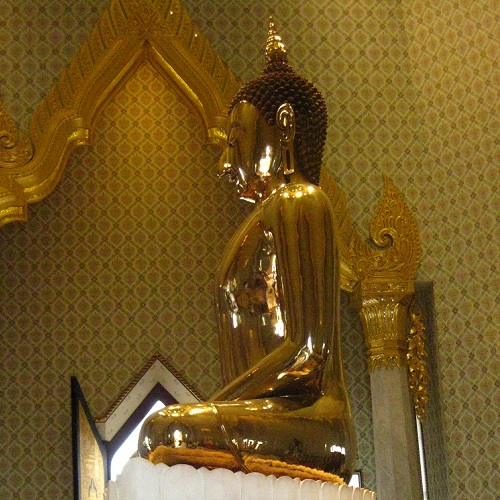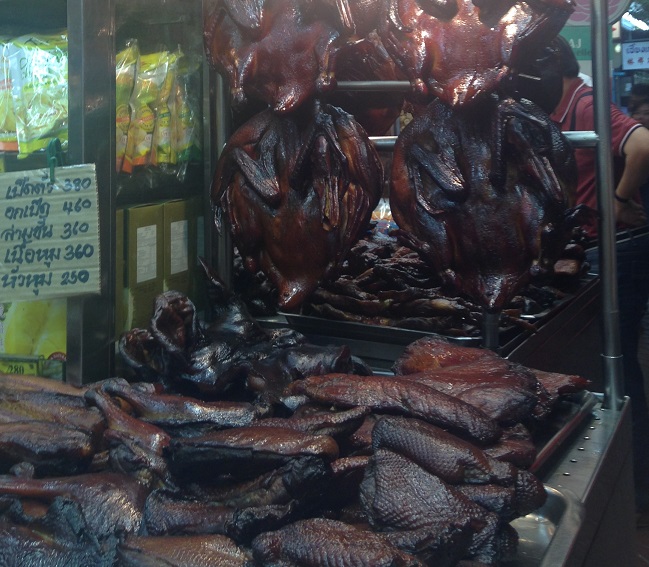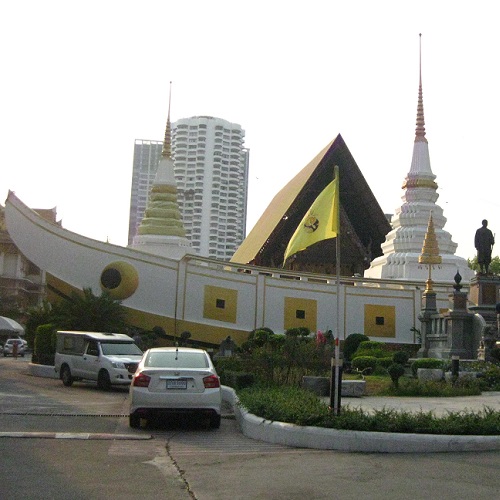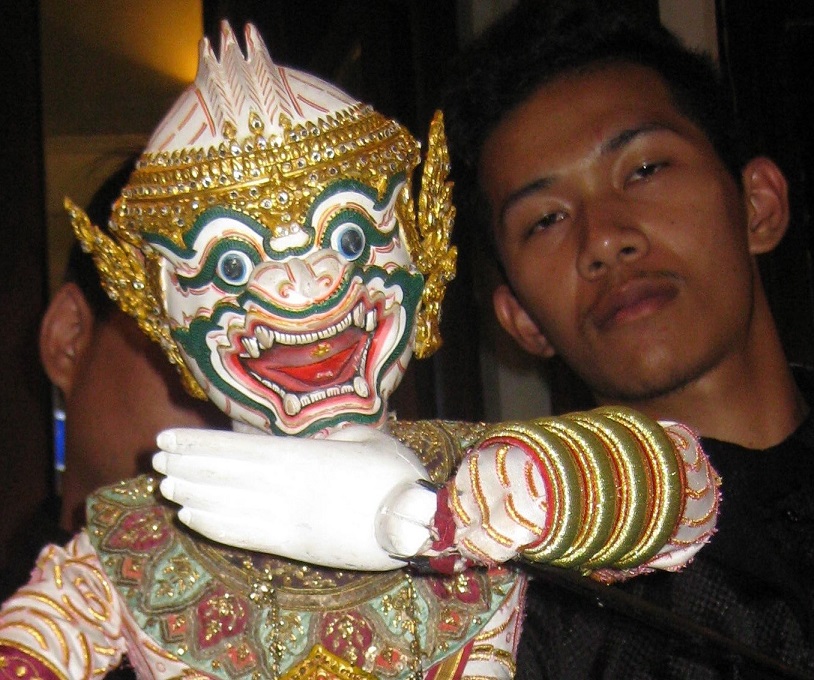We spent two weeks in Bangkok, though we didn’t love it, unfortunately. Here is what we visited:
1) Yaowarat: This is Bangkok’s Chinatown. Like Chinatowns in many countries, that means lots of little houses close together with small alleys and many stalls selling some things Americans don’t necessarily consider food. (A soup made out of a bird’s nest, anyone? How about a violently-detached shark’s fin?) The Thai government tried to displace much of this neighborhood when the real estate grew more valuable; when they didn’t succeed, they resorted to letting foreign investors buy out the residents with dreams of gold. There are two components of this Chinatown: the touristy part and the neighborhood part. The local area is regular houses, cheap shops, and temples with locals. In the tourist area, you’ll find:
- Wat Traimit:
 This place is swarmed by visitors disembarking from giant tour buses and taking dozens of photos of the few people trying to pray at the central shrine. I guess this is no surprise, given what was discovered here. During some regular clean-up, workers dropped a giant plaster Buddha statue, splitting it open…to reveal a giant gold one underneath. There had been a statue like this described in ancient texts, purported to have been hidden when Burmese occupiers came. It’s nice enough to look at, but I found some of the other temple elements (fancy flower sculptures, the real temple next door) more visually interesting.
This place is swarmed by visitors disembarking from giant tour buses and taking dozens of photos of the few people trying to pray at the central shrine. I guess this is no surprise, given what was discovered here. During some regular clean-up, workers dropped a giant plaster Buddha statue, splitting it open…to reveal a giant gold one underneath. There had been a statue like this described in ancient texts, purported to have been hidden when Burmese occupiers came. It’s nice enough to look at, but I found some of the other temple elements (fancy flower sculptures, the real temple next door) more visually interesting. - Wat Chakrawat: It’s on the far end of Chinatown which may be why, at the time we visited, we seemed to be the only tourists there. Guides describe it as having one of the largest monk populations – and a notable alligator population. We saw some of the former and none of the latter, but I enjoyed the pretty “spires” on the temples here best. And the seclusion too. Another less secluded, but similar-looking temple to explore is the Wat Ratchaburana Ratchaworawihan/Wat Liap.
- Food Market:
 Yaowarat Road near Plaeng Nam Road is the center of the markets and stalls that make up Chinatown’s main attraction. There are hundreds of carts and dozens of restaurants selling Chinese and Thai food, including everything from mango sticky rice to fried bugs. I think it’s worth it to walk through the area, especially if you haven’t been to a Chinatown like this. The food tends to be overpriced for being market food, but it’s not terrible.
Yaowarat Road near Plaeng Nam Road is the center of the markets and stalls that make up Chinatown’s main attraction. There are hundreds of carts and dozens of restaurants selling Chinese and Thai food, including everything from mango sticky rice to fried bugs. I think it’s worth it to walk through the area, especially if you haven’t been to a Chinatown like this. The food tends to be overpriced for being market food, but it’s not terrible.
2) Yan Nawa: This was the neighborhood we wished we had stayed in, since it seemed populated by locals, affordable, and relaxed. We saw the cheapest massages in Bangkok here, and we had our first delicious meal here too.
- Wat Yan Nawa:
 This temple has a giant ship replica inside! (The English-language description calls it a ‘junk,’ which is even more fun.) It was commissioned by King Rama III to represent the Chinese ships responsible for the successful trade between China and Thailand. “It was said that the King saw steam ships replacing the old junks, and wanted people to remember the ships that had brought so much prosperity to the kingdom.” Other than that, the primary selling points are: (a) it’s not very crowded, (b) it’s near where you can get on a boat up the Chao Praya River, and (c) there are lots of good places to eat nearby. There’s even a restaurant attached to the temple, though it’s not clear if it’s officially sanctioned by the temple.
This temple has a giant ship replica inside! (The English-language description calls it a ‘junk,’ which is even more fun.) It was commissioned by King Rama III to represent the Chinese ships responsible for the successful trade between China and Thailand. “It was said that the King saw steam ships replacing the old junks, and wanted people to remember the ships that had brought so much prosperity to the kingdom.” Other than that, the primary selling points are: (a) it’s not very crowded, (b) it’s near where you can get on a boat up the Chao Praya River, and (c) there are lots of good places to eat nearby. There’s even a restaurant attached to the temple, though it’s not clear if it’s officially sanctioned by the temple.
3) Asiatique: This is Bangkok’s Navy Pier. There are hundreds of stalls selling clothes, knick knacks, and food. There is also entertainment, from a big ferris wheel to the big drag show in town. As on Navy Pier, this is fun for a bit – especially if you want to drop some money, but it gets a bit stale over time. (If you have limited time, you might want to check out Wat Ratcha Singkhon next door, to see a sample temple complex.)
- Thai Puppet Show:
 We trekked to the King Power Complex (a haven for duty-free shoppers from other countries in Asia), where the internet said this show and box office would be; no dice. It turned out to be at Asiatique (though check before you go, just in case it moves again). The puppets perform at a restaurant, with the show happening right where the tables are. We sat right next to this makeshift stage, and I was worried that we would be in the way. I needn’t have, since the majority of the show is the three puppeteers walking around the restaurant to pose the puppet with all the diners. So, more like Disney character photos than anything else, but still fun to see.
We trekked to the King Power Complex (a haven for duty-free shoppers from other countries in Asia), where the internet said this show and box office would be; no dice. It turned out to be at Asiatique (though check before you go, just in case it moves again). The puppets perform at a restaurant, with the show happening right where the tables are. We sat right next to this makeshift stage, and I was worried that we would be in the way. I needn’t have, since the majority of the show is the three puppeteers walking around the restaurant to pose the puppet with all the diners. So, more like Disney character photos than anything else, but still fun to see.
4) Silom/Bangrak: This is a neighborhood that some describe as Bangkok’s Wall Street, though we only saw it at night, in its party mode. We passed some interesting museums here, like the Seashell and Bangkokian ones described below, and we saw some art galleries too. There was also a big Bangrak market with everything from delicious roti to makeup and knock-off jeans. But the most well-known attraction was the:
- Patpong Market: If you’ve ever heard of the seedy side of Thailand, this is it. It’s an evening/night market made up of stands that sell the standard tourist souvenirs and mango sticky rice. On the perimeter of these sellers are many clubs or bars that seem like strip clubs. But something more illicit happens there. When you enter the market, touts surround you with laminated papers advertising offerings with names like ‘ping pong show.’ Suffice it to say, these are not displays of competitive table tennis – unless you think that terms still applies if instead of racquets, human genitalia is used. That may sound interesting, but because of the commercial nature of it, you end up feeling like a mark being fleeced rather than someone cutting loose.
5) Ratchathewi: This was an accidental neighborhood discovery. Though the original impetus for coming (the Puppet Show, above) was a dud, we did enjoy some markets, massages, and: 
- Santiphap Park: This is just a local park, but we needed the greenery after all the crazy traffic we’ve been in. It’s not a terribly large park, but it has a path around it for jogging, a small kids playground, benches and grass areas to sit on, and even bathrooms. If you happen to be over here, check it out, but any other park should be fairly similar too.
- Victory Monument: B wondered if this would resemble Cambodian independence monuments, which look like brick-colored pineapple, in his opinion. However, this isn’t like that at all. It’s a phallic monument that looks like the obelisk in the Place de la Concorde in Paris or the Washington Monument, with a few people statues at the bottom. Not worth it, in our opinion.
6) Siriraj: This isn’t so much a neighborhood as a giant hospital, named after the baby son of a former king; he unfortunately passed away from dysentery. The hospital is reputed to be good, but their museums are no less melancholy than the naming story:
- Siriraj Bimuksthan Museum: This museum used to be a railway station. It has a nice shiny temple and a very modern look, so you would never guess that most people ignore it in favor of the other museum on the grounds.
- Siriraj Medical Museums:
 Tokyo claims to have the only parasite museum in the world, but that is a technicality: this Bangkok museum includes a museum-sized collection of displays on parasites. Officially, there are five separate museums housed here, in two buildings: The Ellis Pathological Museum, The Sonkran Niyomsane Forensic Medicine Museum, The Parasitology Museum, The Congdon Anatomical Museum and the Sood Sangvichien Prehistoric Museum & Laboratory. We only had time for one of the two buildings, so we saw the pathology, parasitology, and forensic medicine sections. Oh boy. I’ll put it this way: think twice about going if you are squeamish, have eaten in the past ten hours, have been close to someone killed in an unusual way, have no desire to see mummified or preserved bodies, or want to eat ever again. (Though sadly, that last intention did not last long enough for me.) The pathology museum was a good place to start, as it was the least traumatizing for me: a story of the life of the American head of this hospital in the 1800s, diagrams and models of how body parts change with a disease, and baby fetuses in formaldehyde. (No photos were allowed, so you will have to imagine these for yourself, or reference the ones taken by other visitors. The one above is from downstairs, where photos were allowed. Who knew I was so rule-abiding?) That last part is fairly similar to what I saw at the Mutter Museum in Philadelphia, so I was not put off; it felt creepy, but manageable. And then, there was the parasite museum. When leaving that room, I vowed to avoid eating, drinking, touching, approaching, or breathing anything for the remainder of my life. But seriously, when there is a life-size model of a man whose nether regions swell to the size of large watermelons, you really want to avoid whatever he did (exist). And then the piece de resistance: the forensic medicine section. Still scratching imaginary mites on my head, I entered this room without the proper preparation. Ever seen a man’s body sawed through by a propeller? How about a physical model of the various wounds sustained by tsunami victims? How about a mummified rapist (the tamest item in this room)? To say that I felt ill is an understatement. Definitely interesting, but recommended for those with an iron stomach, extensive medical training, or those with extensive coping mechanisms. Don’t say I didn’t warn you.
Tokyo claims to have the only parasite museum in the world, but that is a technicality: this Bangkok museum includes a museum-sized collection of displays on parasites. Officially, there are five separate museums housed here, in two buildings: The Ellis Pathological Museum, The Sonkran Niyomsane Forensic Medicine Museum, The Parasitology Museum, The Congdon Anatomical Museum and the Sood Sangvichien Prehistoric Museum & Laboratory. We only had time for one of the two buildings, so we saw the pathology, parasitology, and forensic medicine sections. Oh boy. I’ll put it this way: think twice about going if you are squeamish, have eaten in the past ten hours, have been close to someone killed in an unusual way, have no desire to see mummified or preserved bodies, or want to eat ever again. (Though sadly, that last intention did not last long enough for me.) The pathology museum was a good place to start, as it was the least traumatizing for me: a story of the life of the American head of this hospital in the 1800s, diagrams and models of how body parts change with a disease, and baby fetuses in formaldehyde. (No photos were allowed, so you will have to imagine these for yourself, or reference the ones taken by other visitors. The one above is from downstairs, where photos were allowed. Who knew I was so rule-abiding?) That last part is fairly similar to what I saw at the Mutter Museum in Philadelphia, so I was not put off; it felt creepy, but manageable. And then, there was the parasite museum. When leaving that room, I vowed to avoid eating, drinking, touching, approaching, or breathing anything for the remainder of my life. But seriously, when there is a life-size model of a man whose nether regions swell to the size of large watermelons, you really want to avoid whatever he did (exist). And then the piece de resistance: the forensic medicine section. Still scratching imaginary mites on my head, I entered this room without the proper preparation. Ever seen a man’s body sawed through by a propeller? How about a physical model of the various wounds sustained by tsunami victims? How about a mummified rapist (the tamest item in this room)? To say that I felt ill is an understatement. Definitely interesting, but recommended for those with an iron stomach, extensive medical training, or those with extensive coping mechanisms. Don’t say I didn’t warn you.
- Water Taxi on Chao Praya River: There are tourist boats that leave from Yan Nawa (above) and do a full loop, stopping at the famous Grand Palace and other such spots. We skipped that route and just took a commuter ferry from the Siriraj side to the Phra Nakhon side of the river. It was only a 10-minute ride, but nice enough for air circulation, vastly better than walking over the farther bridge, and quite a “local” activity.
7) Phra Nakhon: This area is best known for the Grand Palace and wats listed below, which we missed. However, we did get to enjoy:
- Market Right Off the Tian Ferry Port:
 We didn’t set out to come here, but we were hungry, and the food was much more affordable than I would have expected, given the adjacency of the Grand Palace. My primary issue was that we had just come from the Medical Museum of torture, so my desire to eat ever again was minimal. I ordered the most basic cooked vegetables and prayed for parasites and freak random propellers to leave me alone. It was good!
We didn’t set out to come here, but we were hungry, and the food was much more affordable than I would have expected, given the adjacency of the Grand Palace. My primary issue was that we had just come from the Medical Museum of torture, so my desire to eat ever again was minimal. I ordered the most basic cooked vegetables and prayed for parasites and freak random propellers to leave me alone. It was good! - Sanam Luang: This is a bit of a park and a bit of a field right next to the palace. It was pretty nice, surprisingly.
- Wat Chana Songkhram: This is not a particularly well-known temple, but it’s shaded and has lots of parts to explore, both pluses. I liked the mini-shrine to Rama I’s little brother, which gives me hope that when M gets famous, she’ll make me a little corner somewhere to call my own.
- Khao San Road: This is the epitome of tourism in Bangkok and where most people who plan to hit the “top spots” will recommend. We somehow managed to not even have this spot on our list though! Our taxi driver had recommended it, and I remembered hearing the name at some point. It’s a big pedestrian street full of t-shirt boutiques, massage parlors, carts selling Americanized pad thai, and other tourist draws. Not my cup of tea, but you can be guaranteed decent English and the pad thai you’ve come to expect at home.
8) Sukhumvit: This was the area we lived in, and it was tourist central. It’s a hub for skeezy Western men in their 50s and 60s sitting in bars with Thai women (and ladyboys) in their 20s and 30s dressed to kill. The bars have overpriced food and drinks, and they blast club music and air conditioning like there’s no tomorrow. There are also women sitting on the stoops of their “massage parlors” and food cart sellers all over too. If we hadn’t lived there, I likely would have visited, but it’s not exactly my idea of fun. There are also a ton of hotel skyscrapers for tourists and the:
- US Embassy: Hopefully, you have no reason to come here. But, if you do, you might enjoy the murals on the outside of the building. They were painted by kids at Bangkok international/English language schools, and they show some interesting perceptions of both American and Thai stereotypes.

9) Great Outdoor Market: This was an upscale clothing and food market, like Etsy combined with an artisanal food cook-off. More of my scathing critique of its hipster vibe is here.
10) Pak Khlong Talat: I really enjoyed this giant flower market, though I haven’t bought or received flowers (other than plants) in a decade or so. I saw more types and colors of flowers than I ever have, and it was all so vibrant and bright. I even crossed a bustling street with an elderly woman, who was either helping me be less hesitant to cross or requesting my arm for the journey. I would definitely recommend this place and the surrounding streets.
What We Skipped
Temples:
- Grand Palace:
 The palace includes/is adjacent to two wats, which house a 15th century Emerald Buddha (at Wat Phrakaew) and a famous golden reclining Buddha (at Wat Pho). Also there is the Queen Sirikit Museum of Textiles. By the time we arrived there, it was closed for the day, but we did grab a few photos from the outside.
The palace includes/is adjacent to two wats, which house a 15th century Emerald Buddha (at Wat Phrakaew) and a famous golden reclining Buddha (at Wat Pho). Also there is the Queen Sirikit Museum of Textiles. By the time we arrived there, it was closed for the day, but we did grab a few photos from the outside. - Wat Hua Lumphong: We saw the outside, but didn’t go in. It looked crowded and like the other temples we had seen.
- Guru Tawan Sikh Temple: This is the second-largest Sikh temple outside of India, and it has a big gold dome on it. We didn’t get to it though.
- Wat Chai Chana Songkhram: This temple also looks like a ‘junk,’ but with a big white horse at the front. Since we saw Yan Nawa – and since it didn’t seem as meaningful based on descriptions, we skipped it.
Museums:
- Jim Thompson House: This guy was a silk merchant who disappeared under mysterious circumstances in the 1950s. His house is now a museum that describes life in Thailand, and entrance ticket proceeds are said to go to orphaned children. Unfortunately, we got here after hours too.
- Royal Elephant Museum: This is a small museum that wasn’t near anything we were visiting, but the description sounds interesting enough.
- Museum Siam: We just didn’t make it to this museum, which is said to explain Bangkok’s diversity.
- Bangkok Seashell Museum: We stumbled past this museum while walking around in the evening, after it closed. I wish I had read about it beforehand, because it seems really interesting, even for those who know nothing about shells (that would be me).
- Bangkokian Museum: This seemed small at the time, but after seeing how much we enjoyed the ‘folk’ museum/house reconstruction museum in Tokyo, I wish we had gone. Next time!
- Dusit Palace: We ran out of time for this compound of royal residences. Inside is Vimanmek Mansion, which is purported to be the “largest golden teakwood house in the world,” if that’s a superlative you prize.
Other:
- Floating Market: These are just like regular food markets, but on water. The famous one was too touristy (and a bit far) for us to venture to, and we didn’t make it to a smaller, local one – though I wanted to.
- Lumphini Park: This park is said to have paths, people playing chess, Tai Chi classes, and rowboat rentals. We visited a different city park instead.
- Bang Krachao: This is an island in Chao Praya River that features small villages, cycling paths, temples, and lots of green.
- Drag Show: The most famous one of these, at the Calypso Cabaret, seemed quite touristy. More importantly, reviews said that it wasn’t as good as ones we’ve seen in San Francisco, and we didn’t want to sit through a bad performance. The price point wasn’t super convincing either.
- Baiyoke Tower II: This is the tallest building in Thailand, and it has an observatory on the eighty-fourth floor. We saw the building from afar, but we didn’t make it to the top.
- Watch Muay Thai match: We didn’t feel like watching people pummel each other – here or in Koh Phangan.
- Horse Races: We didn’t make it a priority to go.


